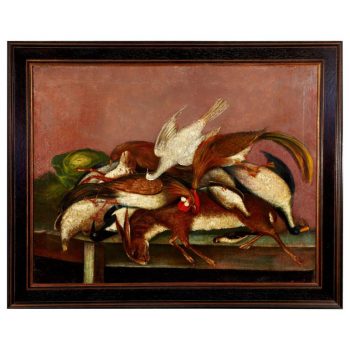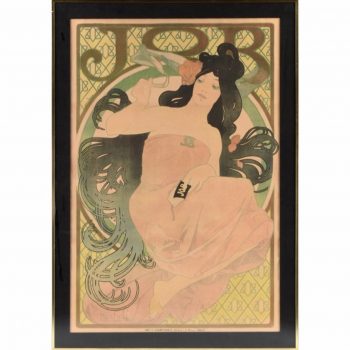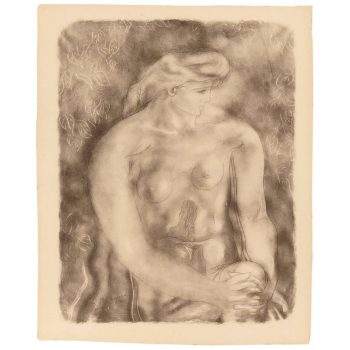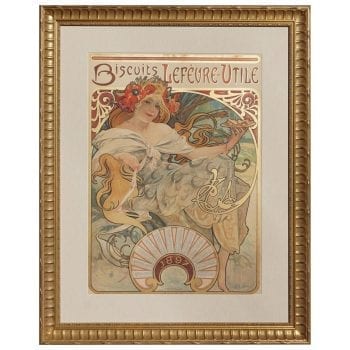Description
Maximilin Luce (French, 1858-1941)
A rather large oil painting by the master impressionist painter depicting the lime stone quarries in Mercourt outside of Paris circa 1920. Luce’s lighting effects with his mastery of pointillism and cubism show the movement and toil of French working men during the Art Deco era. The working class men in Paris know about Mericourt; the largest limestone quarry in France. After WWI, men were rebuilding France to its old glory stone by stone. This painting shows the back breaking work under blue skys where men fixes the rails as they worked to keep production going. The nearby rivers were the highways of the times and were used to transport the stone and lime to distribution hubs along the way. A truly moving and historic painting with a mix of many techniques and styles including impressionism, pointillism the aesthetic movement all in an Art Nouveau – Art Deco Style. A remarkable painting by any standard.
Méricourt, les carrières (Paysage à Méricourt), circa 1925
Oil on board: 16.25 x 31.25 inches (41.3 x 79.4 cm) Framed: 24 X 39.25 Inches Signed lower right: Luce Inscribed on the reverse: 5269 and no. 23
Provenance: Sale: Lombrail, Enghien-les-Bains, April 17, 1983, lot 64; Galerie Leymarie, Paris; Mr. Berman Swarttz, Los Angeles, California, Daughter Marcella Swarttz, Beverly Hills, California Literature: D. Bazetoux, Maximilien Luce: catalogue de l’oeuvre peint, tome II, Paris, 1986, p. 517, no. 2208, illustrated.
This lot is accompanied by a photo-certificate of authenticity signed and dated October 24, 1985 by Denice Bazetoux. Madame Bazetoux has kindly confirmed that this painting is the same as no. 2208 in her catalogue raisonné,
Condition: Just received a thorough cleaning which revealed a fresh pallet of vibrant colors. Black light shows no in-paint. Few minor frays around board. Image presents beautifully. Possible original frame with age related issues and old repairs (presents well).
AVANTIQUES is dedicated to providing an exclusive curated collection of Fine Arts, Paintings, Bronzes, Asian treasures, Art Glass and Antiques. Our inventory represents time-tested investment quality items with everlasting decorative beauty. We look forward to your business and appreciate any reasonable offers. All of our curated items are vetted and guaranteed authentic and as described. Avantiques only deals in original antiques and never reproductions. We stand behind our treasures with a full money back return policy if the items are not as described.
Maximilien-Jules-Constant Luce was born on 13 March 1858 in Paris. His parents, of modest means, were Charles-Désiré Luce (1823–1888), a railway clerk, and Louise-Joséphine Dunas (1822–1878). The family lived in the Montparnasse, a working-class district of Paris. Luce attended school at l’Ecole communale, beginning in 1864. In 1872, the fourteen-year-old Luce became an apprentice with wood-engraver Henri-Théophile Hildebrand (1824–1897). During his three-year xylography apprenticeship, he also took night classes in drawing from instructors Truffet and Jules-Ernest Paris (1827–1895). During this period, Luce started painting in oils. He moved with his family to the southern Paris suburb of Montrouge. His art education continued as he attended drawing classes taught by Diogène Maillard (1840–1926) at the Gobelins tapestry factory. Luce began working in the studio of Eugène Froment (1844–1900) in 1876, producing woodcut prints for various publications, including L’Illustration and London’s The Graphic. He took additional art courses, at l’Académie Suisse, and also in the studio of portrait painter Carolus-Duran (1837–1917). Through Froment’s studio, Luce became friends with Léo Gausson and Émile-Gustave Cavallo-Péduzzi. These three artists spent time around Lagny-sur-Marne creating Impressionist landscapes. Luce spent four years in the military, starting in 1879, serving in Brittany at Guingamp. The next year, he received a promotion to corporal, and he became friends with Alexandre Millerand, who, in 1920, assumed the office of President of France. In 1881 he requested the restoration of his lower rank of soldier, second class. Carolus-Duran used his influence to get a transfer for Luce to Paris barracks. His stint in the military came to a close in 1883. The prevalence of the new zincography printing process rendered xylography nearly obsolete as a profession. When the opportunities for employment as an engraver became scarce, Luce shifted his focus to painting full-time in about 1883. Gausson and Cavallo-Péduzzi introduced Luce in about 1884 to the Divisionist technique developed by Georges Seurat. This influenced Luce to begin painting in the Pointillist style.[4] In contrast to Seurat’s detached manner, Luce’s paintings were passionate portrayals of contemporary subjects, depicting the “violent effects of light”. He moved to Montmartre in 1887. Luce joined the Société des Artistes Indépendants and participated in their third spring exhibition, where Paul Signac purchased one of his pieces, La Toilette. Camille Pissarro and critic Félix Fénéon were also impressed by the seven Luce works displayed in the show. Fénéon characterized Luce as a “coarse, honest man, with a rough and muscular talent”. In addition to Pissarro and Signac, he met many of the other Neo-impressionists, including Seurat, Henri-Edmond Cross, Charles Angrand, Armand Guillaumin, Hippolyte Petitjean, Albert Dubois-Pillet, and Pissarro’s son Lucien. A New York Times critic declared this Pointillist period to be the pinnacle of Luce’s artistic career, singling out the radiant 1895 painting On the Bank of the Seine at Poissy as an example. He described the skillfully executed painting as “a lyrical celebration of nature”. With the exception of the years 1915 to 1919, Luce exhibited in every show at Les Indépendants from 1887 until he died in 1941, including a thirty-year retrospective held in 1926. In 1909, he was elected Vice President of the Société des Artistes Indépendants, and was elected President in 1935, following the death of Signac, who had held the post since 1908. However, in 1940 he resigned from the position as a protest against the Vichy regime’s laws which would have prohibited Jewish artists from participating in the group. Luce had his first solo exhibition, arranged by Fénéon, in July 1888, exhibiting ten paintings at the La Revue indépendante offices He showed six paintings at the 1889 Les XX exhibition in Brussels. While there, he met Les XX official Octave Maus, as well as Symbolist poet Emile Verhaeren and fellow Neo-impressionist painter Théo van Rysselberghe. Luce’s work was also featured in the ninth Les XX exhibition, in 1892. In the spring of 1892 Luce traveled with Pissarro to London. Later that year, he visited Saint-Tropez with Signac, and in the summer of 1893, he went to Brittany. Starting near the early part of the twentieth century, his identification with the Neo-impressionists began to disappear, as he became less active politically, and his artistic style shifted from Neo-impressionism, and he resumed painting in an Impressionist manner. Some of his paintings during this period depicted wounded World War I soldiers arriving from the battlefront to Paris. Luce depicted a diverse range of subjects in his works over a long career. He most frequently created landscapes, but his other works include portraits, still lifes (especially florals), domestic scenes, such as bathers, and images of welders, rolling mill operators, and other laborers.
Please also consider Avantique’s eclectic collection of wonderful fine art paintings with artists such as Emile Albert Gruppe, Alphonse Mucha, Alfred De Breanski, Antoine Blanchard, and Marcel Dyf. We strive to collect the highest-quality paintings in exceptional condition.





